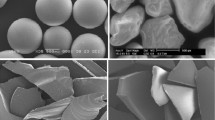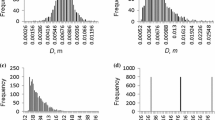Abstract
The macroscopic mechanical behavior of granular materials inherently depends on the properties of particles that compose them. Using the discrete element method, the effect of particle contact friction and polydispersity on the macroscopic stress response of 3D sphere packings is studied. The analytical expressions for the pressure, coordination number and fraction of rattlers proposed for isotropically deformed frictionless systems also hold when the interparticle coefficient of friction is finite; however, the numerical values of the parameters such as the jamming volume fraction change with varying microscopic contact and particle properties. The macroscopic response under deviatoric loading is studied with triaxial test simulations. Concerning the shear strength, our results agree with previous studies showing that the deviatoric stress ratio increases with particle coefficient of friction μ starting from a nonzero value for μ = 0 and saturating for large μ. On the other hand, the volumetric strain does not have a monotonic dependence on the particle contact friction. Most notably, maximum compaction is reached at an intermediate value of the coefficient of friction μ ≈ 0.3. The effect of polydispersity on the macroscopic stress–strain relationship cannot be studied independent of initial packing conditions. The shear strength increases with polydispersity when the initial volume fraction is fixed, but the effect of polydispersity is much less pronounced when the initial pressure of the packings is fixed. Finally, a simple hypoplastic constitutive model is calibrated with numerical test results following an established procedure to ascertain the relation between particle properties and material coefficients of the macroscopic model. The calibrated model is in good qualitative agreement with simulation results.













Similar content being viewed by others
Notes
The average compression (expansion) rate is computed as \(\frac{\Updelta V/V_0}{T_{c}}= \frac{\nu/\nu_0-1}{T_{{\text{c}}}}\) where T c is the half period of the cosine wave displacement function.
The data are not shown during compression but during decompression because of artificial dynamical effects in the former, see [11] for a detailed discussion.
Because of the fluctuations in the simulation results, the stress-strain curves cannot be differentiated easily. In order to obtain smooth curves, a fifth-order polynomial has been fitted to the data, and the slopes have been computed using the fitted curves.
References
Agnolin I, Roux JN (2007) Internal states of model isotropic granular packings. I. Assembling process, geometry, and contact networks. Phys Rev E 76(6):1–27. http://link.aps.org/doi/10.1103/PhysRevE.76.061302
Antony S, Kruyt N (2009) Role of interparticle friction and particle-scale elasticity in the shear-strength mechanism of three-dimensional granular media. Phys Rev E 79(3):31308. http://link.aps.org/doi/10.1103/PhysRevE.79.031308
Bardet J (1994) Observations on the effects of particle rotations on the failure of idealized granular materials. Mech Mater 18(2):159–182. http://linkinghub.elsevier.com/retrieve/pii/0167663694000069
Been K, Jefferies MG (1985) A state parameter for sands. Géotechnique 35(2):99–112. http://www.icevirtuallibrary.com/content/article/10.1680/geot.1985.35.2.99
Christoffersen J, Mehrabadi M, Nemat-Nasser S (1981) A micromechanical description of granular material behavior. J Appl Mech 48(2):339. http://appliedmechanics.asmedigitalcollection.asme.org/article.aspx?articleid=1405787
Cundall PA, Strack ODL (1979) A discrete numerical model for granular assemblies. Géotechnique 29(1):47–65. http://www.icevirtuallibrary.com/content/article/10.1680/geot.1979.29.1.47
Drucker DC, Prager W (1952) Soil mechanics and plastic analysis or limit design. Q Appl Math 10:157–165
Durán O, Kruyt N, Luding S (2010) Micro-mechanical analysis of deformation characteristics of three-dimensional granular materials. Int J Solids Struct 47(17):2234–2245. http://linkinghub.elsevier.com/retrieve/pii/S0020768310001447
Durán O, Kruyt N, Luding S (2010) Analysis of three-dimensional micro-mechanical strain formulations for granular materials: Evaluation of accuracy. Int J Solids Struct 47(2):251–260. http://linkinghub.elsevier.com/retrieve/pii/S0020768309003771
Göncü F, Durán O, Luding S (2009) Jamming in frictionless packings of spheres: determination of the critical volume fraction. In: Nakagawa M, Luding S (eds) Powders and grains 2009: proceedings of the 6th international conference on micromechanics of granular media, Golden, Colorado (AIP, 2009), pp 531–534, 13–17 July 2009
Göncü F, Durán O, Luding S (2010) Constitutive relations for the isotropic deformation of frictionless packings of polydisperse spheres. Comptes Rendus Mécanique 338(10–11):570–586. http://linkinghub.elsevier.com/retrieve/pii/S1631072110001610
Imole OI, Kumar N, Magnanimo V, Luding S (2013) Hydrostatic and shear behavior of frictionless granular assemblies under different deformation conditions. KONA Powder Part J 30:84–108
Jenkins JT, Satake M (eds) (1988) Micromechanics of granular materials. Elsevier, Amsterdam
Kolymbas D (1991) An outline of hypoplasticity. Arch Appl Mech 61:143–154
Kolymbas D (1999) Introduction to hypoplasticity (advances in geotechnical engineering and tunneling) 1st edn. A.A. Balkema, Rotterdam
Kolymbas D, Wu W (1990) Recent results of triaxial tests with granular materials. Powder Technol 60(2):99–119. http://linkinghub.elsevier.com/retrieve/pii/003259109080136M
Luding S (2007) The effect of friction on wide shear bands. Part Sci Technol 26(1):33–42. http://www.tandfonline.com/doi/abs/10.1080/02726350701759167
Luding S (2008) Cohesive, frictional powders: contact models for tension. Granul Matter 10(4):235–246. http://www.springerlink.com/index/10.1007/s10035-008-0099-x
Luding S, Bauer E (2011) Evolution of swelling pressure of cohesive-frictional, rough and elasto-plastic granulates. In: Jiang M, Liu F, Bolton (eds) Geomechanics and geotechnics: from micro to macro, vols 1 and 2. Int Soc Soil Mech & Geotechn Engn (CRC Press-Taylor & Francis Group, 6000 Broken Sound Parkway NW, STE 300, Boca Raton, FL 33487-2742 USA, 2011), pp 495–499
Luding S, Perdahcioglu ES (2011) A local constitutive model with anisotropy for various homogeneous 2D biaxial deformation modes. Chem Ing Tech 83(5):672–688. http://doi.wiley.com/10.1002/cite.201000180
Magnanimo V, Luding S (2011) A local constitutive model with anisotropy for ratcheting under 2D axial-symmetric isobaric deformation. Granular Matter 13(3):225–232. http://www.springerlink.com/index/10.1007/s10035-011-0266-3
Majmudar T, Sperl M, Luding S, Behringer R (2007) Jamming transition in granular systems. Phys Rev Lett 98(5):1–4. http://link.aps.org/doi/10.1103/PhysRevLett.98.058001
Makse H, Johnson D, Schwartz L (2000) Packing of compressible granular materials. Phys Rev Lett 84(18):4160–4163. http://link.aps.org/doi/10.1103/PhysRevLett.84.4160
Mehrabadi M, Loret B, Nemat-Nasser S (1993) Incremental constitutive relations for granular materials based on micromechanics. Proc R Soc A Math Phys Eng Sci 441(1913):433–463. http://rspa.royalsocietypublishing.org/cgi/doi/10.1098/rspa.1993.0072
Miller B, O’Hern C, Behringer R (1996) Stress fluctuations for continuously sheared granular materials. Phys Rev Lett 77(15):3110–3113. http://link.aps.org/doi/10.1103/PhysRevLett.77.3110
Mueth D, Jaeger H, Nagel S (1998) Force distribution in a granular medium. Phys Rev E 57(3):3164–3169. http://link.aps.org/doi/10.1103/PhysRevE.57.3164
Nemat-Nasser S (2000) A micromechanically-based constitutive model for frictional deformation of granular materials. J Mech Phys Solids 48(6–7):1541–1563. http://linkinghub.elsevier.com/retrieve/pii/S0022509699000897
Oda M, Konishi J, Nemat-Nasser S (1982) Experimental micromechanical evaluation of strength of granular materials: effects of particle rolling. Mech Mater 1(4):269–283. http://linkinghub.elsevier.com/retrieve/pii/0167663682900278
Ogarko V, Luding S (2012) Equation of state and jamming density for equivalent bi- and polydisperse, smooth, hard sphere systems. J Chem Phys 136(12):124508. http://www.ncbi.nlm.nih.gov/pubmed/22462875
OHern CS, Silbert LE, Nagel SR (2003) Jamming at zero temperature and zero applied stress: the epitome of disorder. Phys Rev E 68(1):11306–11319. http://link.aps.org/doi/10.1103/PhysRevE.68.011306
Schofield AN, Wroth P (1968) Critical state soil mechanics. 1st edn. McGraw-Hill, London. http://www.worldcat.org/oclc/430956
Shaebani MR, Madadi M, Luding S, Wolf D (2012) Influence of polydispersity on micromechanics of granular materials. Phys Rev E 85(1):011301–011312. http://link.aps.org/doi/10.1103/PhysRevE.85.011301
Silbert L, Ertaş D, Grest G, Halsey T, Levine D (2002) Geometry of frictionless and frictional sphere packings. Phys Rev E 65(3):51302. http://link.aps.org/doi/10.1103/PhysRevE.65.031304
Suiker ASJ, de Borst R (2005) Enhanced continua and discrete lattices for modelling granular assemblies. Philos Trans Ser A Math Phys Eng Sci 363(1836):2543–2580. http://www.ncbi.nlm.nih.gov/pubmed/16243707
Suiker ASJ, Fleck NA (2004) Frictional collapse of granular assemblies. J Appl Mech 71(3):350–358. http://appliedmechanics.asmedigitalcollection.asme.org/article.aspx?articleid=1415151
Suiker A, Metrikine A, de Borst R (2001) Comparison of wave propagation characteristics of the Cosserat continuum model and corresponding discrete lattice models. Int J Solids Struct 38(9):1563–1583. http://linkinghub.elsevier.com/retrieve/pii/S0020768300001049
Tykhoniuk R, Tomas J, Luding S, Kappl M, Heim L, Butt HJ (2007) Ultrafine cohesive powders: from interparticle contacts to continuum behaviour. Chem Eng Sci 62(11):2843–2864. http://linkinghub.elsevier.com/retrieve/pii/S0009250907001893
Wu W, Bauer E, Kolymbas D (1996) Hypoplastic constitutive model with critical state for granular materials. Mech Mater 23(1):45–69. http://linkinghub.elsevier.com/retrieve/pii/0167663696000063
Acknowledgments
This work has been supported financially by the Delft Center for Computational Science and Engineering. Helpful discussions with V. Magnanimo, N. Kumar, W. Wu and J. Tejchman are appreciated.
Author information
Authors and Affiliations
Corresponding author
Appendix: Calibration of the hypoplastic constitutive model
Appendix: Calibration of the hypoplastic constitutive model
The hypoplastic constitutive model given in Eq. (4) can be calibrated for a specific material with the results of a triaxial test [15].
Due to the simple geometry of the test setup, the stress and strain rate tensors are characterized by their principal components:
where compressive stresses are positive.
As illustrated in Fig. 14, the values of (σ 1 − σ 2)max, the slope Footnote 3 E and the angles β A and β B at points A and B can be computed from the test results and are related to \(\mathbf{T}\) and \(\mathbf{D}\):
Since the hypoplastic constitutive model is rate independent, the magnitude of the strain rate \(|\dot{\varepsilon}_1|\) can be arbitrary. However, the sign of \(\dot{\varepsilon}_1\) must be negative due to compression during a conventional triaxial test. Therefore, for simplicity \(\dot{\varepsilon}_1=-1\) is chosen, so that the strain rate tensor \(\mathbf{D}\) at points A and B is:
The stress tensor \(\mathbf{T}\) at points A and B is known:
and the stress rates are given by:
where at the point \(A, \dot{\sigma}_1=E\dot{\varepsilon}_1\) since \(\dot{\sigma_2}=0\) and \(\dot{\varepsilon}_1=-1\).
Substituting \(\mathbf{D},\mathbf{T}\hbox{ and }\dot{\mathbf{T}}\) computed at points A and B into Eq. (4), the following system of equations is obtained with the unknowns C 1, C 2, C 3 and C 4:
where for clarity, the letters A and B have been switched to superscripts when the indicial notation of the tensors is used. The solution to (10) can be obtained by simple matrix inversion using linear algebra or well-known numerical methods such as Gauss–Seidel.
Rights and permissions
About this article
Cite this article
Göncü, F., Luding, S. Effect of particle friction and polydispersity on the macroscopic stress–strain relations of granular materials. Acta Geotech. 8, 629–643 (2013). https://doi.org/10.1007/s11440-013-0258-z
Received:
Accepted:
Published:
Issue Date:
DOI: https://doi.org/10.1007/s11440-013-0258-z





